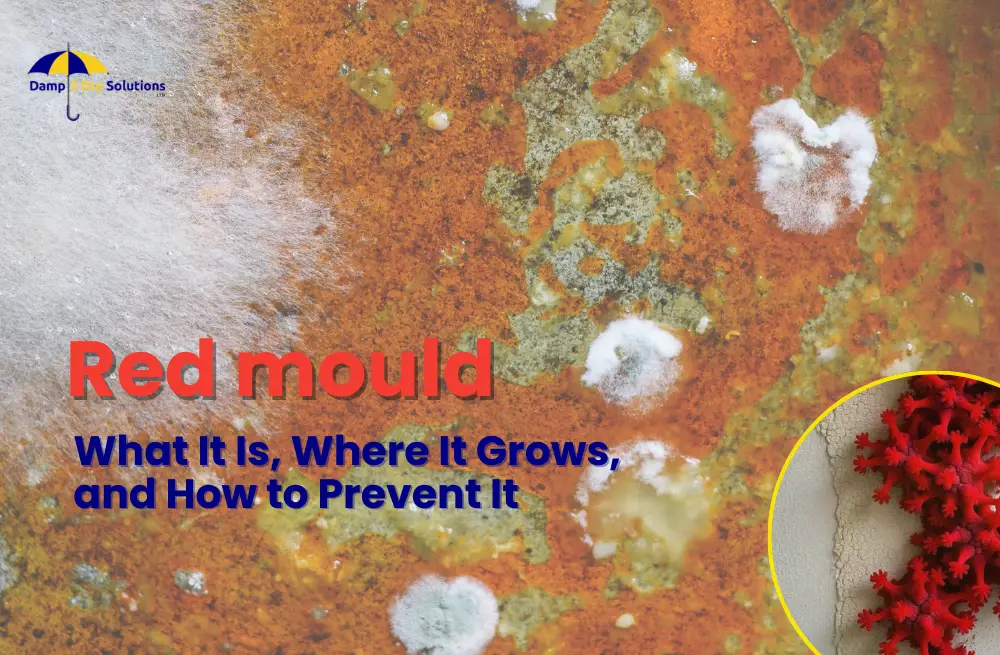
Have you ever walked into your bathroom or kitchen and noticed strange red or pink marks on the tiles, shower curtain, or around the sink? Many people in the UK see it but don’t always know what it is. This is what we call red mould.
Red mould is not always the same type of mould. Sometimes it’s actually a kind of bacteria called Serratia marcescens. Other times it can be a mould such as Fusarium. Either way, it shows up in damp and wet places inside your home.
It often looks slimy and can spread quickly if you don’t clean it. Because the UK has a lot of rain and damp weather, red mould is quite common in older houses and rooms without good ventilation.
Why Does Mould Have a Red Colour?
Most of us think mould is black, orange or green. So why does this one look red?
The colour comes from pigments – natural colours that the mould or bacteria make. For example, Serratia marcescens produces a red pigment called prodigiosin, which makes it look pink or red. Some moulds also create red spores or chemicals as they grow.
In simple words: the mould colours itself red to protect against light and to survive better. That’s why the stains don’t just look random – they are part of how the mould lives.
Where Does Red Mould Usually Grow?
Red mould likes to grow where it is damp, warm, and not very bright. Around UK homes, you’ll often find it:
- Bathrooms – Red mould can grow in the shower, on tiles, silicone around the bath, shower curtains.
- Kitchens – around the sink, in draining boards, even in fridges.
- Laundry rooms – inside washing machines, especially in the rubber seals.
- Windows and walls – where condensation builds up in winter.
- Cellars and basements – damp, dark spaces without much airflow.
If your home is older, or if you don’t have good fans or open windows often, it’s very easy for red mould to appear.
Is Red Mould More Dangerous?
A lot of people worry whether red mould is more dangerous than black mould. The truth is, it can still cause problems, even if it’s not always as harmful.
Here’s what can happen if you ignore it:
- Health problems – red mould can irritate your lungs, make asthma worse, or cause infections in people with weak immune systems.
- Skin issues – touching it may give you rashes or itchy skin.
- Damage to your home – it eats away at grout, silicone, and even plaster.
So, while red mould might not always be as toxic as black mould, it’s still not safe to live with.
Signs of Red Mould
Wondering if what you see is red mould? Here are the common signs:
- Red or pink patches that come back even after cleaning.
- Slimy feel on the surface.
- Musty smell in bathrooms, kitchens, or damp rooms.
- Spreading stains that get bigger over time.
- Allergy-like symptoms such as sneezing, itchy eyes, or breathing problems when you’re near it.
If you keep cleaning it but it always comes back, it’s likely red mould and not just dirt or rust.
How to Prevent Red Mould in the First Place
The best way to deal with red mould is to stop it before it starts. Here are some simple tips:
1. Get the air moving
Use extractor fans in bathrooms and kitchens. Open windows when you can to reduce damp air.
2. Fix leaks
Check taps, pipes, and gutters. Even small drips can keep things wet enough for mould to grow.
3. Clean often
Wipe tiles, sinks, and seals with anti-mould cleaner. Don’t forget hidden places like behind the toilet or under the sink.
4. Use a dehumidifier
This is great for cellars, basements, or older homes where damp builds up.
5. Insulate your home
Good insulation keeps walls warmer, which helps stop condensation.
6. After showers
Wipe tiles and dry the shower curtain or screen. This simple step makes a big difference.
Doing these small things regularly makes it much harder for red mould to grow.
Also read: Does Anti Mould Paint Really Work? and Can you paint over mould?
Final Thoughts
Red mould is more common than you might think, especially in damp UK homes. It may not always be as harmful as black mould, but it’s still a problem for both your health and your property.
Remember: mould means moisture. If you see it, there’s dampness that needs fixing. Clean it, improve airflow, and stop leaks to keep it away.
If red mould has already spread across your bathroom, kitchen, or cellar, simple cleaning won’t be enough. That’s when you need expert help.
For homeowners across Cheshire, Manchester, Liverpool, Stoke-on-trent, Warrington, Chester, and the North West, Damp 2 Dry Solutions offers professional treatments that stop mould at the source and protect your home for the long term.
Email us for a free, no-obligation quote today!

